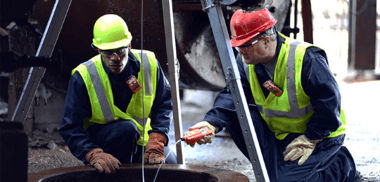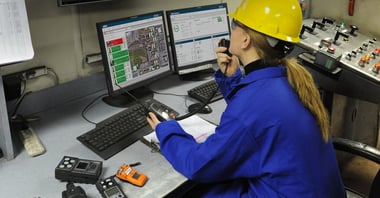Gas hazards can turn deadly in a matter of minutes or seconds. That’s why safety professionals everywhere spend countless hours evaluating solutions to keep their environments, and more importantly people, protected from gas exposures. Whether you’re in the market for a new area monitoring solution, or you’re simply curious about the latest gas detection technology, you can learn how area monitors are improving the jobs of oil and gas safety professionals. Most portable area monitors are similar in function but there are key features to consider when it comes to the visibility, reliability, and usability in the field.
Must-Have Area Monitor Features
1. High Visibility
A large display, loud audible alarms, and bright colored strobes all ensure workers know when the monitor is alarming and why. Gas detection equipment is meant to save people. The area monitor should be visible to anyone potentially being exposed to life-threatening hazards.
2. Long-life Battery
Depending on the type of project and the expected project length, battery life can make a significant difference. The longer the battery life of the area monitor the less often you need to perform maintenance. In some cases, an area monitor can last over seven days which could mean continuous uptime during a short turnaround project with minimal effort to set up. Longer run time also cuts costs by reducing the need to purchase replacement batteries. In some cases, there may even be external power supplies available that allow the area monitor to run indefinitely.
3. Wireless Peer Network
A peer-to-peer network enhances worker safety by easily sharing alarms and gas readings between monitors. When two or more area monitors are in a shared group, they communicate their alarms and gas readings between each other. This allows in-field personnel to learn of and respond to hazardous gas conditions that are detected by any instrument within a group. The peer-to-peer network should not require a central controller, network configuration, or additional infrastructure to work.
4. Smart Sensor Technology
Gas detection equipment is only as good as the sensors detecting the gases. A range of sensor types and redundant sensor technology are must-have features in any good area monitor.
Redundant sensors determine the concentration of the target gas in the atmosphere and reduce the risk of instrument failure. Two sensors of the same type in one gas detector give the most accurate gas reading. Each paired sensor operates independently of its redundant sensor, so the monitor will revert to operate with a single sensor if one of its paired sensors fails. This allows the instrument to continue to operate while a redundant sensor has failed.
Sensor placement is also a key consideration. If the sensors are going to be used in an area that is prone to dirt and dust, keeping sensors protected is critical to operation. For this reason, some area monitors are designed in such a way that the sensors stay clear of dirt, dust, debris, and liquid.
5. Rugged Exterior
When deciding on an area monitoring solution, it’s important to determine where the area monitor will be used. At a minimum, an area monitor should work in all weather conditions and in harsh environments.
6. Easy Set Up
Area monitors are flexible, low-maintenance instruments that should be able to go anywhere for temporary or long-term projects. That’s why it’s important for the area monitoring solution to be easy to set up. Simply powering on the instruments to get started without additional infrastructure leads to time savings and less hassle.
7. Connectivity
An area monitor that connects to cloud software and sends real-time readings and alerts to safety personnel is crucial for responding to incidents as they occur. With cloud connectivity, safety managers can receive instant notification of alarms or events, even from remote locations or a command center. Real-time monitoring can help prevent incidents or expedite response in the event of a true emergency.
8. Communicate to personal gas monitors
The ability for an area monitor to “talk” to a personal gas monitor has many advantages. One application that benefits from these advantages is confined space entry. A person inside of the confined space wearing a personal gas monitor can share readings and alarms with an area monitor outside of the space while the hole watch is observing. If an incident were to occur, the hole watch can respond immediately thanks to the shared readings on the area monitor.
9. Alarm Action Messages
Alarm action messages simplify the user response by providing clear instruction when a unit goes into alarm. Examples of alarm-action messages include EVACUATE or VENTILATE. With this feature, workers can know how to respond to different alarms or events.
Deciding on an area monitoring solution for your operation is a big decision. It’s important to know what features to look for and how those features compare.
Learn more about how Industrial Scientific’s Radius BZ1 Area Monitor can work for you.



